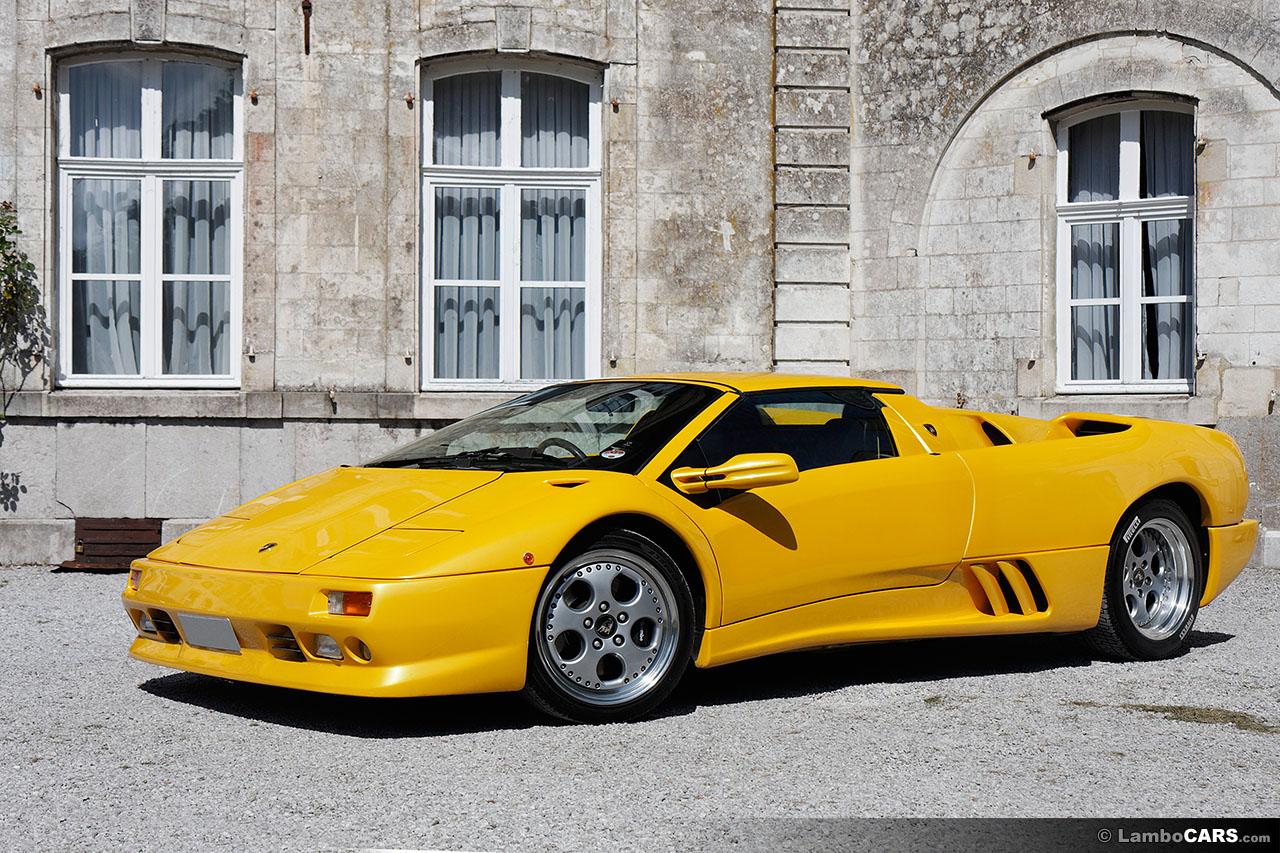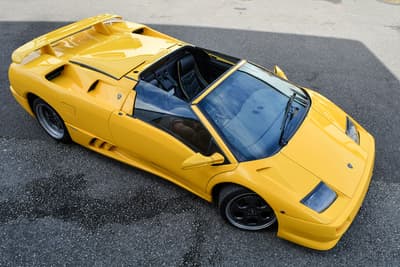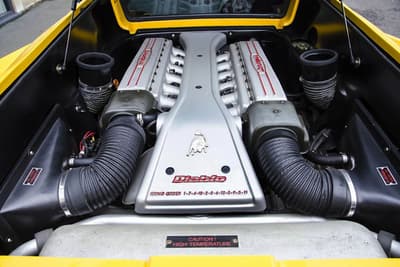Lamborghini is famous for making stylish and fast cars, and they have created many famous models. Two of these are the Lamborghini Countach and the Lamborghini Diablo. This article will look at both cars and compare them, talking about how they are designed, how they perform, and what people like about them.
These two cars were very important when they were made, but they were meant for different types of buyers and had different features. We’ll look at what makes them special, how they are similar, and how they are different.
Historical Background
Countach (1974 – 1990)
The Lamborghini Countach emerged in 1974 as a vision of the future, reflecting the burgeoning space age fascination and unapologetic boldness. Designed by Marcello Gandini at Bertone, its sharp lines and aggressive wedge-shaped design set a trend that continued for years. It was a radical departure from traditional automotive design and set new benchmarks for supercar aesthetics.
Introduced initially with a 4.0-liter V12 engine, later versions saw improvements in displacement and performance. Various iterations and limited editions, such as the 5000 Quattrovalvole, emerged throughout its production run, each fine-tuning the performance or aesthetics. Despite its cutting-edge appearance, the Countach didn’t shy away from offering a raw and visceral driving experience, staying true to Lamborghini’s performance heritage.
Diablo (1990 – 2001)
Launched as the successor to the Countach, the Diablo took on the responsibility of following one of the most iconic supercars ever created. It had to retain the Lamborghini ethos while bringing something fresh and updated to the table. The result was a car that maintained the aggressive stance of the Countach but added more curves, improved aerodynamics, and overall refinement.
Under the guidance of Chrysler, which owned Lamborghini during the early part of Diablo’s life, the car featured a larger 5.7-liter V12 engine that was more powerful and efficient than the one in the Countach. The Diablo underwent numerous updates, with the introduction of all-wheel-drive in some models and embracing new technologies to improve comfort and performance. Special editions like the Diablo SV and Diablo GT further enhanced its appeal.
The transition from Countach to Diablo represented a significant evolution for Lamborghini. While the Countach was all about shocking the world with its audacious design and pure, unfiltered performance, the Diablo was about growing up without losing its edge. It was a car that bridged two eras, taking what was best about the past and pushing it into the future, making it a worthy successor and an icon in its right.
Technical Specifications
| Specification | Countach | Diablo |
| Engine | V12, 4.0L – 5.2L | V12, 5.7L – 6.0L |
| Power | 370-455 hp | 485-575 hp |
| Torque | 268-369 lb-ft | 428-457 lb-ft |
| Transmission | 5-speed manual | 5-speed manual, automatic available |
| 0-60 mph Acceleration | 5.4-4.9 seconds | 4.5-3.9 seconds |
| Top Speed | 179-190 mph | 202-208 mph |
| Weight | 1,490-1,590 kg | 1,575-1,670 kg |
Design
Countach

The Countach’s exterior design was groundbreaking and became an instant icon. Its sharp, wedge-shaped profile was something never seen before in the automotive world. The aggressive lines, broad wheel arches, and distinctive scissor doors created an appearance that was futuristic for its time. Every angle of the car seemed to express speed and power, embodying the essence of a supercar.
The interior of the Countach was more about function than luxury. With a minimalist approach, it provided only essential features and instrumentation, reflecting the era’s sport-oriented focus. The cabin was designed to make the driver feel connected to the road, with minimal distractions. Though not known for comfort, the interior had a raw, race-inspired feel that complemented the exterior’s radical nature.
Diablo

While maintaining the aggressive stance of the Countach, the Diablo introduced more curves, giving it a softer, more aerodynamic appearance. The designers worked on improving the aerodynamic efficiency without losing the distinctive Lamborghini character. The scissor doors remained, linking it to its predecessor, but the car’s lines flowed more gracefully. Diablo’s exterior was a blend of past and future, combining tradition with innovation.
The Diablo marked a shift towards increased attention to comfort and luxury inside the cabin. Unlike the Countach, it featured more refined materials, better ergonomics, and a more sophisticated design. Leather, advanced electronics, and improved noise insulation were part of the package, aiming to provide a more luxurious experience without losing the sporty ambiance. Diablo’s interior represented a step towards modern supercar luxury, balancing performance with daily usability.
The evolution in design from the Countach to the Diablo is a clear illustration of Lamborghini’s ability to adapt and innovate. While the Countach broke all conventional rules and set the stage for supercar design, the Diablo built on that foundation and added layers of refinement and sophistication. Both cars are unmistakable in their appearance and continue to be admired for their distinctive design that embodies the spirit and philosophy of Lamborghini.
Performance and Handling
Countach
- Ride Quality: The Countach’s ride quality was emblematic of a pure sports car. Its stiff suspension system and limited insulation provided a driving experience that connected the driver directly to the road. Every bump and texture could be felt, offering an unfiltered and visceral sensation. Though it may not have been the most comfortable ride, it was authentic and rewarding for those seeking a true performance feel.
- Handling: Handling was an area where the Countach required considerable skill and experience to master. Its steering was heavy and demanded physical effort, particularly at low speeds. The car’s balance and responsiveness were exceptional for the time but required an understanding of its characteristics to extract the best performance. It was a car that provided joy and excitement to those who could tame it but was not very forgiving to the inexperienced.
Diablo
- Ride Quality: With Diablo, Lamborghini introduced a more refined and comfortable ride quality. The suspension was reworked to provide a smoother experience without compromising the sports car’s nature. Innovations in damping and chassis construction contributed to reducing harshness while retaining agility. It was a more approachable supercar that could be enjoyed on longer journeys without sacrificing its performance credentials.
- Handling: Handling in the Diablo was a more forgiving experience compared to the Countach. With improvements in steering responsiveness, electronic aids, and an available all-wheel-drive system in some models, the Diablo offered greater control and stability. These enhancements allowed a wider range of drivers to enjoy the car’s capabilities without feeling overwhelmed. Diablo’s handling was still engaging and challenging but in a more accessible way.
Comparative Analysis
The contrast in performance and handling between the Countach and the Diablo is a reflection of the evolution in automotive engineering and design philosophy during their respective eras. While the Countach remained a raw and unfiltered expression of speed and agility, the Diablo introduced a more sophisticated and user-friendly approach.
The Countach is remembered for its wild and demanding nature, appealing to those looking for an unadulterated driving challenge. The Diablo, on the other hand, opened up the realm of high-performance driving to a broader audience without diluting the essence of what makes a Lamborghini special.
Together, these two models represent the transitional phase in the supercar world, where the pursuit of pure performance began to blend with considerations of comfort and technology. They serve as excellent case studies for understanding the dynamic relationship between performance, handling, and consumer expectations.
Consumer Perspective

Countach Pros:
- Iconic Design: The Countach’s striking appearance set the stage for a whole new design language in the automotive world.
- Raw Performance: Its unfiltered driving experience attracted purists who sought a direct connection with the road.
- Historical Significance: As one of the defining supercars of its era, it carries a timeless appeal for collectors.
Countach Cons:
- Comfort: The focus on performance left little room for comfort and convenience features.
- Practicality: Limited visibility and a lack of modern amenities made daily driving a challenge.
- Maintenance: As a classic car, finding parts and skilled technicians may be difficult and expensive.

Diablo Pros:
- Refined Performance: Improved engine, suspension, and aerodynamics offered enhanced performance without losing its character.
- Luxurious Interior: The Diablo brought in a level of comfort and sophistication previously unseen in Lamborghini’s lineup.
- Technological Advances: The incorporation of modern technologies provided a more user-friendly experience, making it accessible to a broader audience.
Diablo Cons:
- Higher Price: The added refinement and technology came with a higher price tag, both in purchase and maintenance.
- Changing Character: Some purists might argue that Diablo lost some of the Countach’s wild and untamed spirit.
- Complexity: More advanced systems could lead to more expensive upkeep, especially as the car ages.
Practical Considerations
For consumers considering either the Countach or the Diablo, practical considerations must be carefully evaluated. Both models, as classic cars, come with unique challenges:
- Maintenance Costs: Specialized tools and knowledge are often required, making maintenance a potentially costly affair.
- Availability of Parts: Sourcing original parts for these models might be challenging and expensive, particularly for limited editions.
- Insurance: As collectible classics, insurance premiums may be higher, and special coverage might be necessary.
- Investment Potential: Both models have appreciated in value over time, but market fluctuations can affect their investment potential.
- Usage Considerations: The Countach’s raw nature may be more suited for occasional driving, while Diablo’s refinements could allow for more frequent use.
Conclusion
The Countach and Diablo serve as two significant milestones in Lamborghini’s history. While the Countach is revered for its raw and untamed spirit, the Diablo brought refinement and higher performance. Choosing between them depends on individual preferences and priorities, whether valuing a pure sports car experience or seeking a blend of performance and luxury.
For enthusiasts interested in future and past models, it’s worth noting how these cars have influenced subsequent models like the Murciélago and Aventador, carrying forward the brand’s philosophy of innovation and excellence. The legacy of Countach and Diablo continues to shape the manufacturer’s approach to design and engineering, ensuring that Lamborghini remains at the forefront of automotive luxury and performance.


















